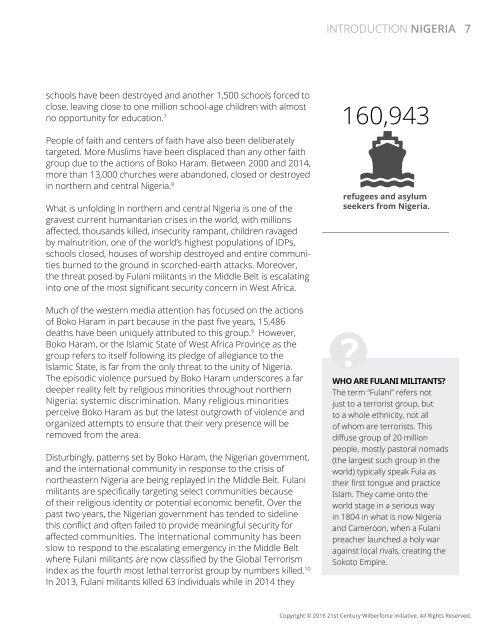NIGERIA
NIgeria-Fractured-and-Forgotten
NIgeria-Fractured-and-Forgotten
Create successful ePaper yourself
Turn your PDF publications into a flip-book with our unique Google optimized e-Paper software.
INTRODUCTION <strong>NIGERIA</strong> 7<br />
schools have been destroyed and another 1,500 schools forced to<br />
close, leaving close to one million school-age children with almost<br />
no opportunity for education. 7<br />
People of faith and centers of faith have also been deliberately<br />
targeted. More Muslims have been displaced than any other faith<br />
group due to the actions of Boko Haram. Between 2000 and 2014,<br />
more than 13,000 churches were abandoned, closed or destroyed<br />
in northern and central Nigeria. 8<br />
What is unfolding in northern and central Nigeria is one of the<br />
gravest current humanitarian crises in the world, with millions<br />
affected, thousands killed, insecurity rampant, children ravaged<br />
by malnutrition, one of the world’s highest populations of IDPs,<br />
schools closed, houses of worship destroyed and entire communities<br />
burned to the ground in scorched-earth attacks. Moreover,<br />
the threat posed by Fulani militants in the Middle Belt is escalating<br />
into one of the most significant security concern in West Africa.<br />
Much of the western media attention has focused on the actions<br />
of Boko Haram in part because in the past five years, 15,486<br />
deaths have been uniquely attributed to this group. 9 However,<br />
Boko Haram, or the Islamic State of West Africa Province as the<br />
group refers to itself following its pledge of allegiance to the<br />
Islamic State, is far from the only threat to the unity of Nigeria.<br />
The episodic violence pursued by Boko Haram underscores a far<br />
deeper reality felt by religious minorities throughout northern<br />
Nigeria: systemic discrimination. Many religious minorities<br />
perceive Boko Haram as but the latest outgrowth of violence and<br />
organized attempts to ensure that their very presence will be<br />
removed from the area.<br />
Disturbingly, patterns set by Boko Haram, the Nigerian government,<br />
and the international community in response to the crisis of<br />
northeastern Nigeria are being replayed in the Middle Belt. Fulani<br />
militants are specifically targeting select communities because<br />
of their religious identity or potential economic benefit. Over the<br />
past two years, the Nigerian government has tended to sideline<br />
this conflict and often failed to provide meaningful security for<br />
affected communities. The international community has been<br />
slow to respond to the escalating emergency in the Middle Belt<br />
where Fulani militants are now classified by the Global Terrorism<br />
Index as the fourth most lethal terrorist group by numbers killed. 10<br />
In 2013, Fulani militants killed 63 individuals while in 2014 they<br />
160,943<br />
refugees and asylum<br />
seekers from Nigeria.<br />
?<br />
WHO ARE FULANI MILITANTS?<br />
The term “Fulani” refers not<br />
just to a terrorist group, but<br />
to a whole ethnicity, not all<br />
of whom are terrorists. This<br />
diffuse group of 20 million<br />
people, mostly pastoral nomads<br />
(the largest such group in the<br />
world) typically speak Fula as<br />
their first tongue and practice<br />
Islam. They came onto the<br />
world stage in a serious way<br />
in 1804 in what is now Nigeria<br />
and Cameroon, when a Fulani<br />
preacher launched a holy war<br />
against local rivals, creating the<br />
Sokoto Empire.<br />
Copyright © 2016 21st Century Wilberforce Initiative. All Rights Reserved.


